Thanks to Kingmaker's comeback, Owlcat could make Pathfinder: Wrath of the Righteous a sandbox as varied as a tabletop campaign
Pathfinder: Kingmaker rose from the dead, and Owlcat Games returned to its rules and setting for another old school CRPG.

"To be honest, the release of Kingmaker was not ideal," says Oleg Shpilchevskiy, who is head of Owlcat Games and also a master of understatement. "It had quite a lot of problems in the beginning."
The Russian studio's first RPG, Pathfinder: Kingmaker, arrived in 2018 beset by bugs, slow loading times, and difficulty that didn't so much bounce up and down as rocket-jump. After release, Owlcat got to work improving Kingmaker, with patches whose notes were so long they sometimes had to be spread over two Steam news posts.
"We had to make a lot of changes," Oleg says. "A lot of fixes in the first two weeks and even first months, which taught us a lot." As well as patching Kingmaker, the studio added to it with DLC (some of it free), and extras like a turn-based mode in addition to its default realtime-with-pause setting (inspired by a popular Kingmaker mod).
Replaying Kingmaker today is quite a different experience than it was in 2018. Turn-based combat means area-of-effect spells actually hit the enemies you want, and your characters don't charge into battle directly over traps that have already been discovered. It's easier to manage your kingdom thanks to crisis points that can be spent to improve the odds of dealing with disasters, while the build points you need for construction and research projects can be bought right there in the kingdom management menu rather than by exiting it, then physically leaving your throne room to find the one merchant in your settlement who sells them.
...what we see with Kingmaker is a steady wave of new people coming in
Oleg Shpilchevskiy
These days, Kingmaker has a 78% positive rating on Steam and the majority of its negative reviews date from the two months after its release. It's built up a word-of-mouth reputation in CRPG circles as an old-fashioned fantasy sandbox that can be obtuse, but is still worthy of being numbered among the better revivalist CRPGs, alongside Pillars of Eternity and the modern Wasteland and Shadowrun games.
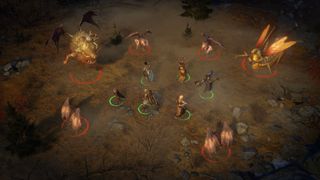
"Games have a peak in sales in the beginning, in the first half a year, and then maybe a short tail of popularity and sales in a year or two, but what we see with Kingmaker is a steady wave of new people coming in," says Oleg, who describes it as a long-tail seller. "And this tail is quite stable, which is really surprising."
For Owlcat's second game, the studio returned to Pathfinder—a tabletop ruleset created by Paizo, who published the official D&D magazines Dragon and Dungeon for five years. Paizo built Pathfinder on D&D's open-licensed third edition, and created a huge catalogue of campaigns for it called adventure paths. Kingmaker was adapted from one of them, and so is the follow-up, Wrath of the Righteous, meaning that although it's also set on the shared world of Golarion it's not a direct sequel.
PC Gamer Newsletter
Sign up to get the best content of the week, and great gaming deals, as picked by the editors.
Alexander Mishulin, creative director of Owlcat Games, says Golarion is a setting worth returning to thanks to its varied locations. He mentions some places the videogames haven't visited yet, like Galt, "all this flair of French Revolution" with "guillotines that chop the heads off enemies of the state and suck their soul into the blade." Elsewhere there's "Cheliax with those hellknights" and a "whole cult devoted to devils."
"You can just point to any part of the world and something is happening there," Alexander says.

The adventure paths are varied too, telling stories about all kinds of characters, from pirates and thieves to runelords and detectives. Owlcat has a shortlist of favorites they'd like to implement. I have to ask though, is Reign of Winter one of them? Maybe the most out-there adventure path, in Reign of Winter the players get hold of the infamous witch Baba Yaga's magic hut, and then use it to cross space and time. They leave Golarion behind, traveling first to a planet called Triaxus and then to Earth, where they visit Siberia and fight Rasputin. It's gloriously demented: Doctor Who with swords and a chicken-hut TARDIS.
"Reign of Winter is the adventure path we sometimes joke about," says Alexander, "because by the end of the Reign of Winter you are returning through time and space to the Russian Empire back in the start of the 20th century, I guess it's something like 1910? You're running across a train with people shooting at you and headless Cossacks chasing you and whatnot."
Initially we thought it will be too difficult, kind of cramming two games together
Alexander Mishulin
It's "too weird" he says, breaking my heart. Owlcat focused on less odd adventure paths, favoring those that lend themselves to management mechanics, like Kingmaker did. "We like when the game has some kind of strategic layer to it because it allows us to introduce our companions, our characters, into that different perspective in addition to your usual RPG experience," Alexander says. "You can see your characters not only as friends and traveling companions, but also as people who are governing with you, making tough choices."
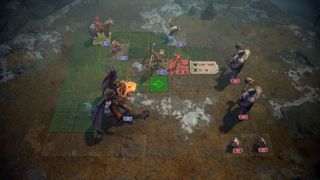
That made Wrath of the Righteous a strong contender. It's an adventure path that elevates players into field commanders of a crusade in the Worldwound, a land overrun by demons. The concept suggested a tactical battle layer where you're essentially playing a wargame. "Initially we thought it will be too difficult," Alexander says, "kind of cramming two games together." Owlcat have an advantage, however, as the studio was founded by former members of Nival Interactive, responsible for strategy games like Heroes of Might & Magic 5. Alexander was that game's creative director, and one of its lead designers. In the end, they decided it was worth bolting a tactical wargame onto their RPG after all. "We know how to do this," as Alexander says.
That's not the only reason the studio chose Wrath of the Righteous, and Oleg highlights another. "It has a brilliant feature: mythic paths." In Pathfinder, mythic paths provide high-level adventurers with further opportunities for mastery, letting wizards become archmages, warriors become champions, priests become hierophants, and so on. Owlcat decided that wasn't epic enough, however. "We want to take them one step further from the tabletop version," Alexander says. "Imagine, what if you're not just an archmage, but something bigger, like a lich?"
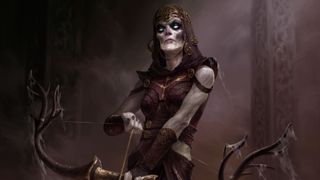
The idea of becoming an evil undead necromancer came from one of Owlcat's playthroughs of the pen-and-paper version of Wrath of the Righteous. As they had with Kingmaker, Owlcat split into groups, busted out the dice, and played the adventure path before and during development. One of those groups came up with the idea of taking on the demons with an army of undead—fighting fire with fire, except the second kind of fire is burning corpses. It's the kind of plan that seems perfectly logical to players sitting around the table, though of course the adventure's writers hadn't considered it.
It caught on with Owlcat in a big way, the team immediately brainstorming ways to make it work in a videogame. "You see people light up from inside when they talk about lich," says Alexander, "because there are several games, old RPGs, that allow you to play lich, and people remember those games and how cool it was. Just fountaining ideas, 'How can we do this? And that, and that, and that?' It's rather difficult to stop them doing this."
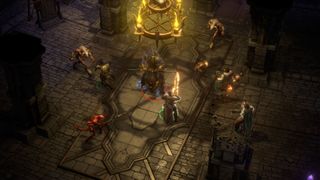
That excitement carried over to the videogame's other mythic paths, all of which needed to be just as extra. A lot of concepts were thrown around, and it wasn't easy to cull them down to the nine in the finished game. "It was a huge fight inside the team," Alexander says. "Which ones should be going in? I don't remember the exact amount of them, but it was way more."
What is better at fighting demons than an angel?
Alexander Mishulin
"It was 16 from the beginning," Oleg says with a sigh. "And I said we'd all die [if we tried] to make all of them. Because initially I wanted just four, or maybe six at maximum. Yeah." He sighs again.
The mythic paths aren't just selections of bonus powers. Each has a specific story trigger to unlock it, a quest or decision, and subsequent story beats to commit to it. They may involve a degree of physical transformation, and they transform the structure of the game as well, with NPCs reacting differently based on your mythic path and different solutions to problems presenting themselves.
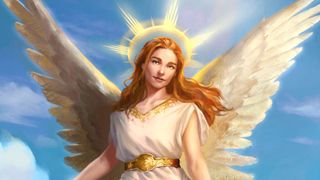
The lich mythic path was joined by angel ("What is better at fighting demons than an angel?"), demon ("People will react very differently to the person who's slowly turning into the demon while leading the crusade against the demons"), as well as a cosmic judge called an aeon, and an option for players who want to remain mortal, the living legend, which will be a harder road but come with its own rewards.
Then there's the azata, a butterfly-themed fey champion with powers sourced from a dimension of untouched nature and compassionate freedom. Alexander says that becoming an angel is what you do if you care about the long game of defeating demonkind, but what matters to an azata is: "This person here is suffering and I have to help this person. Sometimes it's impulsive, sometimes it's more deliberate, but it's closer to superheroes."
Another mythic path, and one I'm partial to, lets you become a trickster—basically a demigod of pranks and goofs. "It's a very dark and epic adventure, and sometimes you have to play, laugh, have fun," says Alexander, "and humor is a great contrast to the dark things." That's why the trickster casts spells like Summon Beer Elemental and Rain of Halberds.
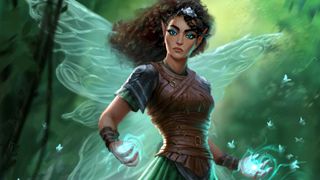
One turns you into, yes, a dragon, and the other into essentially a gang of bugs walking around in a suit
Some mythic paths have access to different troops they can add to the crusade, and tricksters are no different. "For trickster troops we chose powerful but quite ridiculous builds of players," Alexander says. Pathfinder is the kind of system that assumes players will be min-maxing a bit, but some go the extra yard. For instance, multiclassing into paladin for the ability to add Charisma bonus to your saving throws, dipping into monk so you can add Charisma bonus to your armor class as well, then into other Charisma-themed classes until you end up a nonsensical but untouchable kung-fu holy knight sorcerer or something. "Narratively speaking, it's kind of a strange thing, but mechanically it's a beast. A trickster can summon those guys onto the battlefield for you, and they will help you defeat an army of demons because they're so good at it."
Two more unusual mythic paths were added as Kickstarter stretch goals: golden dragon and swarm-that-walks. One turns you into, yes, a dragon, and the other into essentially a gang of bugs walking around in a suit. Oleg is deliberately vague on how that one works to avoid spoiling some story stuff, saying only that it's going to involve some particularly significant changes to the game. "You're becoming the thing that loves to consume its enemies," he says. Sounds delightful.
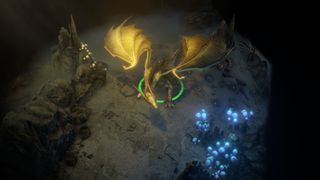
When raising funds for Kingmaker, Owlcat turned to Kickstarter because there weren't a lot of other ways for a new studio to get money. But the real benefit of Kickstarter, Oleg says, is the relationship they were able to develop with players. The backers stuck with them through Kingmaker's rough launch, providing bug reports and suggestions. Getting feedback from "superfans" motivates the team, Oleg says, and is the reason they chose to crowdfund various Wrath of the Righteous extras on Kickstarter. "This is the main reason," Oleg says, then laughs. "Money is also a good one!"
The Kickstarter campaign helped them see what players were most interested in, and which stretch goals they were most excited by. Some added more classes, races, ways for pets to evolve, and mounted combat. In particular, the promise of "doubled reactivity" went down well—the idea that NPCs would have more unique dialogue based on your class, religion, or other choices, that companions would chat more at camp and be more likely to jump into conversations to offer commentary.

"It's always great to give additional screen time to your companions and allow them to shine because this is the way they grow into multifaceted characters," says Alexander. "They express their opinions, they argue with your decisions, they argue with each other, and you start to believe in them."
Alexander was... I can't say against animal races in the game...
Oleg Shpilchevskiy
While some of those companions are drawn from the original adventures, others were new creations. Oleg explains that the writers came up with a bunch of options, wanting characters who represented a broad selection of classes, alignments, and so on. "After that, there's a process which may be close to how they choose a new Pope," he says. "All writers close doors, and then there is an internal meeting among them." Characters who make the cut are then distributed among the writers who argued most passionately for their inclusion, and then become responsible for their quests and dialogue, becoming "a kind of great fan of this exact companion."
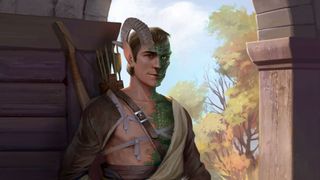
Another stretch goal promised to add one of Pathfinder's animal-themed species as a playable option, and let backers vote for their favorite out of catfolk, ratfolk, and the fox people called kitsune. Alexander says that, given the popularity of cats on the internet, it seemed like catfolk might have an edge over the others. "It was like, 'Oh yeah, out of those three, cats kinda have an advantage.' But then the foxes start winning."
The foxes continued winning, ending up with 52% of the final vote (surprisingly, ratfolk came second), and the kitsune ended up in the final game. "It's a kind of internal joke in the studio," says Oleg, "because to be honest Alexander was... I can't say against animal races in the game, but he believes that it to a certain extent spoils the consistency of the world."
"When you add a bunch of animalistic races it starts to work out closer to a fairy tale," Alexander explains. In the end he relented, though a similar argument played out when another option was suggested: dinosaurs. Rideable dinosaurs.
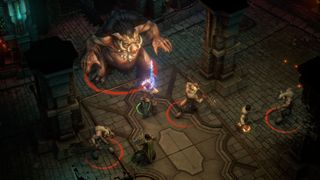
"Those are very great in terms of mechanics and they're very nice to look at," says Alexander, "and a lot of people just love dinosaurs, but crashing into the demons on your tooth raptors, it's a little bit of a shift into the Reign of Winter stuff." Again he relented, and if you want your holy cavalier to charge into battle on a dinosaur in Wrath of the Righteous, they absolutely can.
Let's say we like our secrets
Alexander Mishulin
There's precedent for that, since dino steeds and pets are right there in the Pathfinder rulebooks. I'm glad Owlcat remains open to putting things in simply because players want them, since that's the reason turn-based combat has now made it into both games despite Owlcat's preference for realtime-with-pause. The goofy trickster was added for the sake of players who want something tonally different to the grim Worldwound, and the lich and demon were based on players in the team's playtest games wanting to go full evil. These games are classic sandboxes, and sandboxes are better with more toys to choose from.
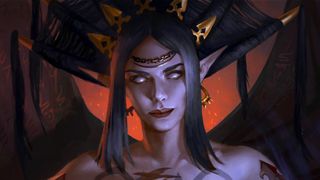
Finally, before I let them off the hook I have to ask about the possibility of a secret ending. Kingmaker had one, and players spent weeks puzzling it out until finally discovering the exact sequence of steps required. (Basically, it involves romancing a character you might not think is romanceable, via an extremely specific and sometimes obscure set of actions.) It's a motivation to replay a game that can stretch to 100 hours, and a way of bringing the community together as they work together to figure it out. Is there something similar in Wrath of the Righteous? "Let's say we like our secrets" is all Alexander will tell me.
Oleg throws me a bone, though for all I know he's pulling my leg. "We don't even have a secret ending," he says, "we have a super secret ending."

Jody's first computer was a Commodore 64, so he remembers having to use a code wheel to play Pool of Radiance. A former music journalist who interviewed everyone from Giorgio Moroder to Trent Reznor, Jody also co-hosted Australia's first radio show about videogames, Zed Games. He's written for Rock Paper Shotgun, The Big Issue, GamesRadar, Zam, Glixel, Five Out of Ten Magazine, and Playboy.com, whose cheques with the bunny logo made for fun conversations at the bank. Jody's first article for PC Gamer was about the audio of Alien Isolation, published in 2015, and since then he's written about why Silent Hill belongs on PC, why Recettear: An Item Shop's Tale is the best fantasy shopkeeper tycoon game, and how weird Lost Ark can get. Jody edited PC Gamer Indie from 2017 to 2018, and he eventually lived up to his promise to play every Warhammer videogame.
Most Popular


